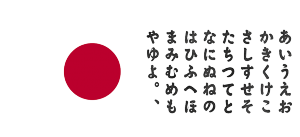Difference between revisions of "Language/Japanese/Pronunciation/Alphabet-and-Pronunciation"
(Опечатка) Tags: Mobile edit Mobile web edit |
|||
| Line 1: | Line 1: | ||
[[File:japanese-alphabet- | [[File:japanese-alphabet-pronunciation.png|thumb|none]] | ||
Japanese language uses three ways to express sounds and writing ː Hiragana, Katakana and Kanji. | Japanese language uses three ways to express sounds and writing ː Hiragana, Katakana and Kanji. | ||
Revision as of 18:28, 30 December 2016
Japanese language uses three ways to express sounds and writing ː Hiragana, Katakana and Kanji.
There are to simple symbols tables called "Hiragana" and "Katakana" and the borrowed chinese caracters called Kanji.
Hiragana
Hiragana is the most common character used to write things. You can find it everywhere, in restaurant name, dishes, train stations...
| あ | A | か | KA | さ | SA | た | TA | な | NA | は | HA | ま | MA | や | YA | ら | RA | わ | WA |
| い | I | き | KI | し | SHI | ち | CHI | に | NI | ひ | HI | み | MI | り | RI | ||||
| う | U | く | KU | す | SU | つ | TSU | ぬ | NU | ふ | FU | む | MU | ゆ | YU | る | RU | ん | N |
| え | E | け | KE | せ | SE | て | TE | ね | NE | へ | HE | め | ME | れ | RE | ||||
| お | O | こ | KO | そ | SO | と | TO | の | NO | ほ | HO | も | MO | よ | YO | ろ | RO | を | WO |
Also, to form some sounds like Z, P or B we have to use some additional symbols to complete basic ones.
゛ (dakuten) Makes K becomes G, S become Z, T becomes D, H becomes B
° (handakuten) Makes H becomes P
| が | GA | ざ | ZA | だ | DA | ば | BA | ぱ | PA | |
| ぎ | GI | じ | JI | ぢ | DI | び | BI | ぴ | PI | |
| ぐ | GU | ず | ZU | づ | DZU | ぶ | BU | ぷ | PU | |
| げ | GE | ぜ | ZE | で | DE | べ | BE | ぺ | PE | |
| ご | GO | ぞ | ZO | ど | DO | ぼ | BO | ぽ | PO |
Notes ː
as you can see, for "W" sound, there is only A and O.
Concering the "Y" section, there is no I or E.
Also, to form some sounds like Z, P or B we have to use some additional symbols to complete basic ones.
゛ Makes K becomes G, S become Z, T becomes D, H becomes B
° Makes H becomes P
The pronunciation of じ and ぢ, ず and づ are the same.
Katakana
Based on the same concept than hiragana, katakana is especially made to translate foreign names and words
| ア | A | カ | KA | サ | SA | タ | TA | ナ | NA | ハ | HA | マ | MA | ヤ | YA | ラ | RA | ワ | WA |
| イ | I | キ | KI | シ | SHI | チ | CHI | 二 | NI | ヒ | HI | ミ | MI | リ | RI | ||||
| ウ | U | ク | KU | ス | SU | ツ | TSU | ヌ | NU | フ | FU | ム | MU | ユ | YU | ル | RU | ン | N |
| エ | E | ケ | KE | セ | SE | テ | TE | ネ | NE | へ | HE | メ | ME | レ | RE | ||||
| オ | O | コ | KO | ソ | SO | ト | TO | ノ | NO | ホ | goo | モ | MO | ヨ | YO | ロ | RO | ヲ | WO |
| ガ | GA | ザ | ZA | ダ | DA | バ | BA | パ | PA | |
| ギ | GI | ジ | JI | ヂ | DI | ビ | BI | ピ | PI | |
| グ | GU | ズ | ZU | ヅ | DU | ブ | BU | プ | PU | |
| ゲ | GE | ゼ | ZE | デ | DE | ベ | BE | ペ | PE | |
| ゴ | GO | ゾ | ZO | ド | DO | ボ | BO | ポ | PO |
There is a small difficulty in katakana symbols table due to the very similar looking of some characters ː ノ、ソ、ン、シ、ツ...+ゾ、ジ、ヅ。
The pronunciation of ジ and ヂ, ズ and ヅ are the same.
Kanji
Sometimes, kanji are used to make the sound only, without any consideration for the meaning.
One first example ː 可愛い KAWAII which means cute.
可 (KA) means possible, so nothing relative to cute.
愛 (AI)
い ( I̟s ̟) unsoud for I I " letter
.
So we have KA AI I . As it is no easy to pronounce AAII a W has been added to help the flow of word.
